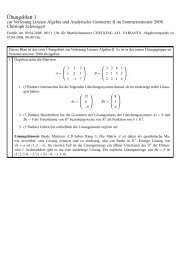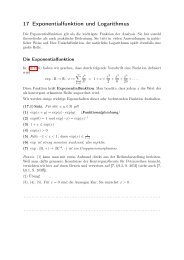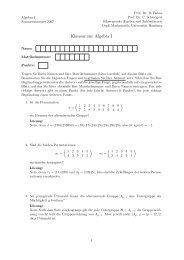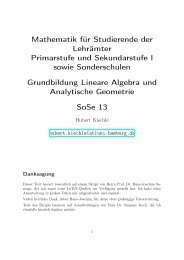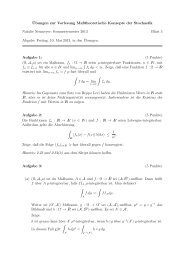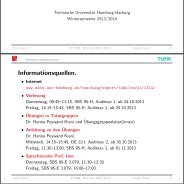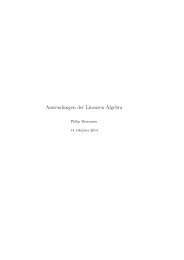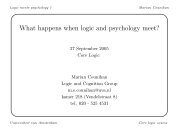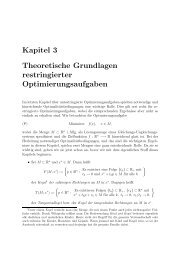pdf file
pdf file
pdf file
You also want an ePaper? Increase the reach of your titles
YUMPU automatically turns print PDFs into web optimized ePapers that Google loves.
Remarks A.2.3.<br />
1. This reduces the study of bilinear maps to the study of linear maps.<br />
2. We first show that the tensor product, if it exists, is unique up to unique isomorphism.<br />
Suppose we have two maps<br />
having each the universal property.<br />
κ : V × W → V ⊗ W ˜κ : V × W → V ˜⊗W .<br />
Using the universal property of κ for the specific bilinear map ˜κ, we find a unique linear<br />
map Φ˜κ : V ⊗ W → V ˜⊗W with Φ˜κ ◦ κ = ˜κ.<br />
Exchanging the roles of κ and ˜κ, we obtain a linear map Φ κ : V ˜⊗W → V ⊗ W with<br />
Φ κ ◦ ˜κ = κ. The maps κ = id V ⊗W ◦ κ and Φ κ ◦ Φ˜κ ◦ κ describe the same bilinear map<br />
V × W → V ⊗ W . The uniqueness statement in the universal property implies Φ κ ◦ Φ˜κ =<br />
id V ⊗W . Similarly, we conclude Φ˜κ ◦ Φ κ = id V ˜⊗W .<br />
3. To show the existence of the tensor product, chose a basis B := (b i ) i∈I of V and B ′ :=<br />
(b ′ i) i∈I ′ of W . Since a bilinear map is uniquely determined by its values on all pairs<br />
(b i , b ′ j) i∈I,j∈I ′, we need a vector space with a basis indexed by these pairs. Thus define<br />
V ⊗ W as the vector space freely generated by the set of these pairs. We denote by b i ⊗ b ′ j<br />
the corresponding element of the basis of V ⊗ W .<br />
The bilinear map κ is then defined by κ(b i , b ′ j) := b i ⊗ b ′ j. It has the universal property:<br />
to any bilinear map α : V × W → X, we associate the linear map ˜α : V ⊗ W → X with<br />
˜α(b i ⊗ b ′ j) = α(b i , b ′ j).<br />
4. As a corollary, we conclude that for finite-dimensional vector spaces V, W , the dimension<br />
of the tensor product is dim V ⊗ W = dim V ∙ dim W .<br />
5. The elements of V ⊗ W are called tensors; elements of the form v ⊗ w with v ∈ V and<br />
w ∈ W are called simple tensors. The simple tensors span V ⊗ W , but there are elements<br />
of V ⊗ W that are not tensor products of a vector v ∈ V and w ∈ W .<br />
Observation A.2.4.<br />
Given K-linear maps<br />
we obtain a K-linear map<br />
ϕ : V → V ′ ψ : W → W ′<br />
ϕ ⊗ ψ : V ⊗ W → V ′ ⊗ W ′<br />
on the tensor products. To this end, consider the commuting diagram:<br />
V × W ⊗<br />
V ⊗ W<br />
ϕ×ψ<br />
<br />
ϕ⊗ψ<br />
<br />
V ′ × W ′ ⊗ V ′ ⊗ W ′<br />
Since the map ⊗ ◦ (ϕ × ψ) is bilinear, the universal property of the tensor product implies the<br />
existence of a map ϕ ⊗ ψ for which<br />
holds.<br />
(ϕ ⊗ ψ)(v ⊗ w) = ϕ(v) ⊗ ψ(w)<br />
155






